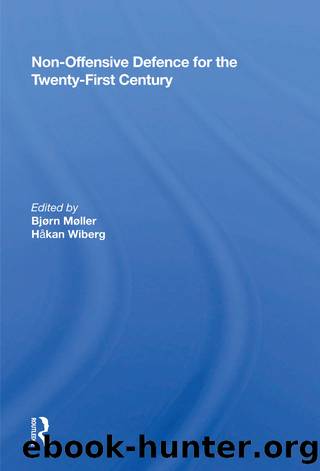Non-Offensive Defence for the Twenty-First Century by Bjorn Moller

Author:Bjorn Moller [Moller, Bjorn]
Language: eng
Format: epub
ISBN: 9780367009441
Google: 5ofFxgEACAAJ
Goodreads: 51220439
Publisher: Routledge
Published: 2019-05-07T00:00:00+00:00
New Thinking and NOD
The ensuing confrontation precipitated (but did not cause) the systemic crisis in the East and led, initially, to the painful reappraisal of national security policy attempted by Mikhail Gorbachev.
His opening move was the rejection of the twenty-five years old dogma of the "winnability" of a nuclear war. The November, 1985 Geneva communique stating that "nuclear war cannot be won and must not be fought" had important implications for the Soviet military. It effectively unravelled the concept of victory in a conventional war between nuclear powers as well, since it was judged inconceivable that such nations, when faced with the prospect of a defeat, would not use their nuclear weapons as a last resort.
This important doctrinal innovation was followed, in early 1986, by the enunciation of "reasonable sufficiency" as the guiding principle of future Soviet military policy. The official (muddled) Soviet explanation of that concept was that, in terms of size and quality, the Soviet armed forces were now to reflect the actual military threat and minimum defence requirements. For conventional forces, that meant enough capabilities to stop the advancing enemy and defeat his invading force. In May 1987 the Warsaw Pact then announced its "new defensive doctrine" that contained, for the first time, several tenets in broad agreement with the NOD concept. The following month the Soviet General Staff made a statement to the effect that henceforth the actions of Soviet forces would primarily consist of defensive operations. The main novelty was that war was no longer believed to be inevitable, but could and had to be prevented. It was proposed, then, that military potentials of NATO and the Pact be reduced to a level adequate for defence but insufficient for offence. The sights were set very high: to eventually exclude "the veiy military-technical possibility of one side attacking of other" (Prauda, 30 May 1987).
These broad declarations mainly affected what the Soviets called the doctrine's "socio-political element" (i.e. intentions). Changes in its "military-technical element" (i.e. capabilities) were much slower to arrive. Although the twin concepts of "defensive sufficiency" and of "defensive strategy" were soon put forward, both remained vague, superficial and open to wide interpretation. Few were those who, like Andrei Kokoshin and retired Major-General Valentin Larionov, preached the case of intentional defence (1987). The more traditional "offensive defence" still ruled virtually supreme. Commenting on the new doctrine, a deputy Soviet defence minister stressed that its adoption did not mean "that our actions will be passive... In case of an aggression our Armed Forces... will defend the gains of socialism with the utmost decisiveness" (Shabanov 1987: 18). It was also claimed (using NATO's FOFA doctrine as an example) that the boundary between offence and defence was being eroded. Despite universal references to "sufficiency" and renewed interest in defence, NOD was hardly mentioned at all.
"New thinking", however, was making progress in political practice, if not in military theory. Its first fruit was the INF treaty signed in December 1987. In many ways it was a watershed. After INF the fundamentals of previous Soviet defence policies were openly put into question.
Download
This site does not store any files on its server. We only index and link to content provided by other sites. Please contact the content providers to delete copyright contents if any and email us, we'll remove relevant links or contents immediately.
What's Done in Darkness by Kayla Perrin(25500)
Shot Through the Heart: DI Grace Fisher 2 by Isabelle Grey(18219)
Shot Through the Heart by Mercy Celeste(18160)
The Fifty Shades Trilogy & Grey by E L James(17774)
The 3rd Cycle of the Betrayed Series Collection: Extremely Controversial Historical Thrillers (Betrayed Series Boxed set) by McCray Carolyn(13189)
The Subtle Art of Not Giving a F*ck by Mark Manson(12912)
Scorched Earth by Nick Kyme(11831)
Stepbrother Stories 2 - 21 Taboo Story Collection (Brother Sister Stepbrother Stepsister Taboo Pseudo Incest Family Virgin Creampie Pregnant Forced Pregnancy Breeding) by Roxi Harding(11040)
Drei Generationen auf dem Jakobsweg by Stein Pia(10216)
Suna by Ziefle Pia(10185)
Scythe by Neal Shusterman(9259)
International Relations from the Global South; Worlds of Difference; First Edition by Arlene B. Tickner & Karen Smith(8608)
Successful Proposal Strategies for Small Businesses: Using Knowledge Management ot Win Govenment, Private Sector, and International Contracts 3rd Edition by Robert Frey(8419)
This is Going to Hurt by Adam Kay(7694)
Dirty Filthy Fix: A Fixed Trilogy Novella by Laurelin Paige(6453)
He Loves Me...KNOT by RC Boldt(5804)
How to Make Love to a Negro Without Getting Tired by Dany LaFerrière(5378)
Interdimensional Brothel by F4U(5304)
Thankful For Her by Alexa Riley(5161)
